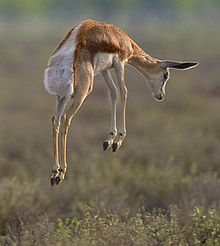Antidorcas is a genus of antelope that includes the living springbok and several fossil species.[1][2]
| Antidorcas Temporal range: Pliocene–Recent
| |
|---|---|

| |
| Scientific classification | |
| Domain: | Eukaryota |
| Kingdom: | Animalia |
| Phylum: | Chordata |
| Class: | Mammalia |
| Order: | Artiodactyla |
| Family: | Bovidae |
| Subfamily: | Antilopinae |
| Tribe: | Antilopini |
| Genus: | Antidorcas Sundevall, 1847 |
| Type species | |
| Antidorcas marsupialis (Zimmermann, 1780)
| |
| Species | |
|
1 living, several extinct (see text) | |
Modern Taxonomy edit
In 2013, Eva Verena Bärmann (of the University of Cambridge) and colleagues undertook a revision of the phylogeny of the tribe Antilopini on the basis of nuclear and mitochondrial data. They showed that the springbok and the gerenuk (Litocranius walleri) form a clade with saiga (Saiga tatarica) as sister taxon.[3] The study pointed out that the saiga and the springbok could be considerably different from the rest of the antilopines; a 2007 phylogenetic study even suggested that the two form a clade sister to the gerenuk.[4] The cladogram below is based on the 2013 study.[3]
Species edit
References edit
- ^ Hendey, Q.B. (1974). "THE LATE CENOZOIC CARNIVORA OF THE SOUTHWESTERN CAPE PROVINCE SOUTH AFRICA". Annals of the South African Museum. Annale van die Suid-Afrikaanse Museum. 63: 1–369.
- ^ Faith, J. Tyler (2014). "Late Pleistocene and Holocene mammal extinctions on continental Africa". Earth-Science Reviews. 128: 105–121. doi:10.1016/j.earscirev.2013.10.009.
- ^ a b Bärmann, E.V.; Rössner, G.E.; Wörheide, G. (2013). "A revised phylogeny of Antilopini (Bovidae, Artiodactyla) using combined mitochondrial and nuclear genes". Molecular Phylogenetics and Evolution. 67 (2): 484–493. doi:10.1016/j.ympev.2013.02.015. PMID 23485920.
- ^ Marcot, J.D. (2007). "Molecular phylogeny of terrestrial artiodactyls". In Prothero, D.R.; Foss, S.E. (eds.). The Evolution of Artiodactyls (Illustrated ed.). Baltimore: Johns Hopkins University Press. pp. 4–18. ISBN 978-0-8018-8735-2.